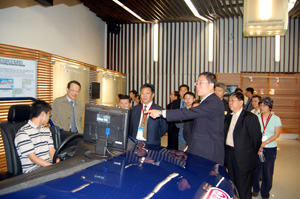Delegation of Chinese Automotive Execs Visits Taiwan Auto Research Center
2010/03/03 | By Quincy LiangA delegation of more than 50 leaders of China's automotive industry recently visited Taiwan's Automotive Research & Testing Center (ARTC), the island's top vehicle testing facility and automotive-electronics R&D hub.

Afterwards, ARTC claimed that all the members of the delegation, which was headed by vice chairman Dong Yang of the China Association of Automobile Manufacturers (CAAM), were highly impressed, especially by Taiwan's strength in the development of auto electronics and electric vehicles.
ARTC was the core organizer of the recent Conference on Cross-strait Cooperation and Exchange in the Automobile (Including Battery Energy Storage) Industry, which was held on Nov. 23-25 at the Taipei International Convention Center. The conference provided a platform for over 500 senior automotive executives from Taiwan and China to discuss opportunities for cooperation following the expected signing of the Economic Cooperation Framework Agreement (ECFA). There were also displays of major R&D achievements by the local automotive, including electric vehicles, industry.
On the last day of the meeting, CAAM and the China Automotive Technology and Research Center (CATRC) signed three letters of intent for cooperation with the Taiwan Transportation Vehicle Manufacturers' Association (TTVMA) and Taiwan Automotive Research Consortium (TARC). TARC has five main members: ARTC, the Mechanical and System Research Laboratories (MS) of the Industrial Technology Research Institute (ITRI), the Chung-Shan Institute of Science and Technology (CSIST), the Metal Industries Research and Development Center (MIRDC), and the Hua-chuang Automobile Information Technical Center Co. (HAITEC). About 120 private manufacturers and suppliers also belong.
ARTC reported that the Chinese delegation visited all of its major facilities, including test tracks, collision-text laboratory, vibration/noise lab, and R&D achievement demonstration center. The members were said to have been pleased with ARTC's R&D capability in the fields of advanced automotive safety, clean energy, intelligent traffic control, optical imaging, and chassis systems.
Among the items catching the most attention from the group, according to ARTC, were an advanced parking guidance system (APGS), blind-spot monitoring system, and sensor-based adaptive front-lighting system. The Chinese auto executives were also impressed with ARTC's patent deployment.
The APGS uses advanced ultrasonic and image-identification technology to detect surrounding obstacles and help drivers park easily and safely. A driver of an APGS-equipped vehicle has only to push a button and take his or her hands off the steering wheel, and let the vehicle park itself. This is easier, safer, and more efficient than manual parking, because the computer figures out the best way to maneuver into a parking space and the electronic steering puts the vehicle there.
Citing statistics compiled by a company called Strategy Analytics, ARTC said that demand for APGS would reach 15 million units in 2010 and 24 million in 2015. This implies lucrative opportunities in the APGS field. Only a handful of companies currently possess the needed technology, however, including Aisin of Japan, Valeo of France, and Bosch of Germany. APGS has so far been installed in only two car models, the VW Tiguan and the Lexus LS460.
ARTC president Joe Huang stressed that the conference and the visit by the Chinese delegation marked the beginning of a period of more intensive interaction between the automotive industries on the two sides of the Taiwan Straits.




